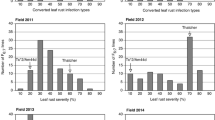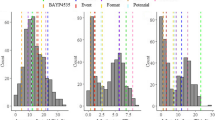Abstract
DNA-based molecular markers have been used in numerous studies for tagging specific genes in wheat for subsequent use in marker-assisted selection. Usually in plant breeding, procedures for mapping genes are based on analysis of a single segregating population. However, breeding programmes routinely evaluate large numbers of progeny derived from multiple-related crosses with some parental lines shared. In most such related crosses, the number of progeny is quite small. Thus, statistical techniques for detecting quantitative trait loci (QTLs) using data from conventional multi-cross breeding programmes are interesting. The objective of this study is to present a mixture model for QTL mapping in crosses of multiple inbred varieties with non-normal phenotype distributions and to use this model to map QTLs for yellow rust resistance in elite wheat breeding material. Three doubled haploid populations consisting of 41, 42 and 55 lines, respectively, originating from four parental varieties were studied. Multi-cross QTL analysis with three specific pathogen isolates of Puccinia striiformis f. sp. tritici and a mixture of the isolates revealed QTLs for resistance at four different genomic locations. These QTLs were found on chromosome 2AL, 2AS, 2BL and 6BL and explained between 21 and 41% of the phenotypic variation. Two of these QTLs, one on the long arm of chromosome 2A and one on the short arm of chromosome 2A were identical to the known yellow rust resistance genes Yr32 and Yr17, respectively, whereas the QTLs located on the long arms of chromosomes 2B and 6B may reflect types of resistance to yellow rust, which have not previously been mapped.






Similar content being viewed by others
References
Bennett MD, Smith JB (1976) Nuclear DNA amounts in angiosperms. Phil Trans R Soc Lond B 274:227–274
Bink MCAM, Uimari P, Sillanpää MJ, Janss LLG, Jansen RC (2002) Multiple QTL mapping in related plant populations via a pedigree-analysis approach. Theor Appl Genet 104:751–762
Broman KW (2003) Mapping quantitative trait loci in the case of a spike in the phenotype distribution. Genetics 163:1169–1175
Broman KW, Wu H, Sen S, Churchill GA (2003) R/qtl: QTL mapping in experimental crosses. Bioinformatics 19:889–890
Buerstmayer H, Lemmens M, Hart L, Doldi L, Steiner B, Stierschneider M, Ruckenbauer P (2002) Molecular mapping of QTLs for Fusarium head blight resistance in spring wheat. I. Resistance to fungal spread (Type II resistance). Theor Appl Genet 104:84–91
Calonnec A, Johnson R, De Vallavieille-Pope C (2002) Genetic analysis of resistance of the wheat differential cultivars Carstens V and Spaldings Prolific to two races of Puccinia striiformis. Plant Pathol 51:777–786
Chen X, Line RF (1993) Inheritance of stripe rust (yellow rust) resistance in the wheat cultivar Carstens V. Euphytica 71:107–113
Chen XM, Moore M, Milus EA, Long DL, Line RF, Marshall D, Jackson L (2002) Wheat stripe rust epidemics and races of Puccinia striiformis f.sp. tritici in the US in 2000. Plant Dis 86:39–46
Churchill GA, Doerge RW (1994) Empirical threshold values for quantitative trait mapping. Genetics 138:963–971
Dempster AP, Laird NM, Rubin DB (1977) Maximum likelihood from incomplete data via the EM algorithm. J R Stat Soc B 39:1–38
Devos KM, Bryan GJ, Collins AJ, Stephenson P (1995) Application of two microsatellite sequences in wheat storage proteins as molecular markers. Theor Appl Genet 90:247–252
Ellis MH, Spielmeyer W, Gale KR (2002) ‘Perfect’ markers for the Rht-B1b and Rht-D1b dwarfing genes in wheat. Theor Appl Genet 105:1038–1042
Eriksen L, Borum F, Jahoor A (2003) Inheritance and localisation of resistance to Mycosphaerella graminicola causing septoria tritici blotch and plant hight in the wheat (Triticum aestivum L.) genome with DNA markers. Theor Appl Genet 107:515–527
Eriksen L, Afshari F, Christiansen MJ, McIntosh RA, Jahoor A, Wellings CR (2004) Yr32 for resistance to stipe (yellow) rust present in the wheat cultivar Carstens V. Theor Appl Genet 108:567–575
Feenstra B, Skovgaard IM (2004) A quantitative trait locus mixture model that avoids spurious LOD score peaks. Genetics 167:959–965
Helguera M, Khan IA, Kolmer J, Lijavetzky D, Zhong-qi L, Dubcovsky J (2003) PCR assay for the Lr37-Yr17-Sr38 cluster of rust resistance genes and their use to develop isogenic hard red spring wheat. Crop Sci 43:1839–1847
Holloway JL, Knapp SJ (1993) GMendel 3.0 users guide. Department of Crop and Soil Science, Oregon State University
Ihaka R, Gentleman R (1996) R: a language for data analysis and graphics. J Comp Graph Stat 5:299–314
Jannink J-L, Jansen RC (2001) Mapping epistatic quantitative trait loci with one-dimensional genome searches. Genetics 157:445–454
Jansen RC, Jannink J-L, Beavis WD (2003) Mapping quantitative trait loci in plant breeding populations: use of parental haplotype sharing. Crop Sci 43:829–834
Justesen AF, Ridout CJ, Hovmøller MS (2002) The recent history of Puccinia striiformis f.sp. tritici in Denmark as revealed by disease incidence and AFLP markers. Plant Pathol 51:13–23
Kao C-H, Zeng Z-B (1997) General formulas for obtaining the MLEs and the asymptotic variance-covariance matrix in mapping quantitative trait loci when using the EM algorithm. Biometrics 53:653–665
Liu Y, Zeng Z-B (2000) A general mixture model approach for mapping quantitative trait loci from diverse cross designs involving multiple inbred lines. Genet Res 75:345–355
Louis TA (1982) Finding the observed information matrix when using the EM algorithm. J R Stat Soc B 44:226–233
McNeal FH, Konzak CF, Smith EP, Tate WS, Russell TS (1971) A uniform system for recording and processing cereal research data. US Agric Res Ser 42:34–121
R Development Core Team (2005) R: A language and environment for statistical computing. R Foundation for Statistical Computing, Vienna, Austria. ISBN 3-900051-07-0, URL http://www.R-project.org
Rebaï A, Goffinet B (1993) Power of tests for QTL detection using replicated progenies derived from a diallel cross. Theor Appl Genet 86:1014–1022
Röder MS, Korzun V, Wendehake K, Plaschke J, Tixier M-H, Leroy P, Ganal W (1998) A microsatellite map of wheat. Genetics 149:2007–2023
Saghai-Maroof MA, Soliman KM, Jorgensen RA, Allard RW (1984) Ribosomal DNA spacer length polymorphisms in barley: Mendelian inheritance, chromosomal lacation and population dynamics. Proc Natl Acad Sci USA 81:8014–8018
Schachermayr G, Feullet C, Keller B (1997) Molecular markers for the detection of the wheat leaf rust resistance gene Lr10 in diverse genetic backgrounds. Mol Breed 3(65):65–74
Schiex T, Gaspin C (1997) Carthagene: constructing and joining maximum likelihood genetic maps. In: Proceedings of the 5th international conference on intelligent systems for molecular biology. Porto Carras, Halkidiki, pp 258–267
Somers DJ, Isaac P, Efwards K (2004) A high-density microsatellite consensus map for bread wheat (Triticum aestivum L). Theor Appl Genet 109:1105–1114
Stubbs RW (1985) Stripe rust. In: Roelfs AP, Bushnell WR (eds) The cereal rusts, vol 2. Academic, London, pp 61–101
Voorrips RE (2002) MapChart: software for graphical presentation of linkage maps and QTLs. J Hered 93:77–78
Xu S (1998) Mapping quantitative trait loci using multiple families of line crosses. Genetics 148:517–524
Zadoks JC (1961) Yellow rust on wheat studies in epidemiology and physiologic specialization. Tijdschrift over Plantenziekten 67:69–256
Acknowledgements
We thank Dr. MS Hovmøller (Danish Institute of Agricultural Sciences, Flakkebjerg, Denmark) for providing Puccinia striiformis isolates for this study and for helpful comments on the manuscript. MJ Christiansen was supported by a grant from The Danish Ministry of Science, Technology and Innovation. The wmc markers were developed by the Wheat Microsatellite Consortium managed by Agrogene (620 Rue Blaise Pascal, Z.I., 77555 Moissy Cramayel, France).
Author information
Authors and Affiliations
Corresponding author
Additional information
Communicated by T. Lübberstedt
Rights and permissions
About this article
Cite this article
Christiansen, M., Feenstra, B., Skovgaard, I. et al. Genetic analysis of resistance to yellow rust in hexaploid wheat using a mixture model for multiple crosses. Theor Appl Genet 112, 581–591 (2006). https://doi.org/10.1007/s00122-005-0128-7
Received:
Accepted:
Published:
Issue Date:
DOI: https://doi.org/10.1007/s00122-005-0128-7




